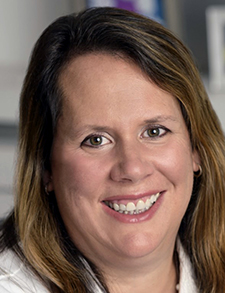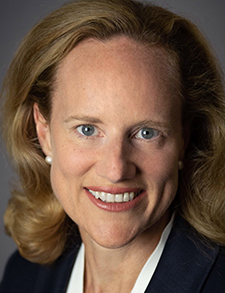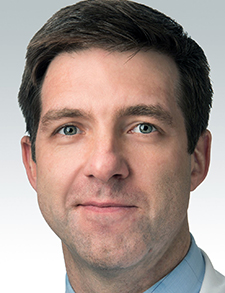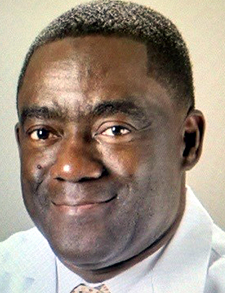Most working hospitalists will see cancer patients regularly on their hospital rounds since it’s the main underlying condition for many hospital admissions—whether for the disease itself, side effects from cancer treatments, or possibly coincidental medical issues.
But a smaller number of hospitalists are focusing their practices on oncology patients, working with oncologists who—like many outpatient-based physicians before them throughout the history of hospital medicine—have found it ever harder to make in-person visits to their patients in the hospital.
At Memorial Sloan Kettering Cancer Center (MSKCC) in New York, which has one of the first and largest oncology hospitalist groups with nearly 60 members, the hospitalists assume responsibility for managing the care of patients admitted to the cancer center, consulting when needed by phone or email with the patients’ oncologists.

Dr. Egan
“We were founded 19 years ago when I was hired as Memorial’s first hospitalist,” said Barbara Egan, MD, FACP, SFHM, chief of the hospital medicine service at MSKCC. “I think it started as something of an experiment by the chief of gastrointestinal oncology at the time, Dr. David Kelsen, who had an insight that what was bringing cancer patients into the hospital was mostly internal medicine problems like symptom management, infections, and late- or end-stage disease management.” These did not require the expertise of a medical oncologist, she explained.
“He convinced them to hire me, and so I fell into the role. I was intrigued by the opportunity to start something new and to see where it could go. The experiment went swimmingly.”
Hospitalists’ added value
Oncology hospitalists typically are internal medicine physicians who care for acutely ill, hospitalized cancer patients, working closely with their outpatient oncologists. At MSKCC, the hospitalists’ added value to the health system is to free up the oncologists so they can spend more time in the system’s varied outpatient clinic settings, bringing more patients into the system, as well as on clinical trials and advancing oncology science.
In other settings, the oncology hospitalist (or onco-hospitalist) may co-manage cancer patients with their oncologist, whether in a cancer hospital, a cancer unit of a general hospital, or scattered around the hospital. There are also board-certified oncologists who perform the hospitalist’s inpatient role for defined periods of time, based in oncology settings within a hospital.

Dr. Morris
Little research has been published on outcomes for onco-hospitalists. One recent study from the Yale Cancer Center and Smilow Cancer Hospital in New Haven, Conn., published in May in the Journal of Hospital Medicine, found that oncology hospitalists decreased lengths of hospital stay, increased inpatient capacity, and reduced reported job stress among oncologists—while maintaining high-quality inpatient care.1
“We’re not unique for cancer centers, and we weren’t trailblazers,” said Jensa Morris, MD, the study’s lead author and director of the hospitalist service at Smilow. “Most major cancer centers now have onco-hospitalists. Here at Yale, the oncologists were expected to be responsible for caring for their hospitalized patients. But among the oncologists themselves, there was a growing sense that maybe inpatient care was out of their wheelhouse—that this complex, high-acuity inpatient medical management would be better served by having a hospitalist take the lead.”

Dr. Gombos
Geographically, Yale oncologists are spread across most of Connecticut, often too far to come to the hospital in person. The patients have medical care needs all day long, and that wasn’t something their oncologists could provide. Plus they have so many other demands on their time, said Dr. Morris, who has been a hospitalist since 2002.
“We established this program so we can reassure the patient that their oncologist is in the loop, making management decisions with us,” said her hospitalist colleague, Erin Gombos, MD. “While the patient is in the hospital, we reach out to the oncologist to give them the back story.” Communication is frequent, typically by email. “Realistically, the management is mostly up to us, and then when the patient is ready for discharge, we get back to them with a full report,” Dr. Gombos said.
Earning the oncologists’ trust
“We gained traction and our program took off when we earned the medical oncologists’ trust by demonstrating to them that we did our job well,” Dr. Egan said. “For them to allow us to join the team at MSKCC, even for the short period of time the patient is in the hospital, and take over the day-to-day care of the patient, they have to be able to trust us.”
The learning curve for this job is long and steep, and turnover by the hospitalists would have been a program killer. “It’s too much of an investment to get people up to speed in this subspecialty area and then have them leave.” That has meant recruiting and retaining strong clinicians who can learn, on the job, a working knowledge of oncologic conditions and treatments, she said.
But it is particularly challenging since new onco-hospitalists at MSKCC are asked to spend their first few years as nocturnists, only working night shifts. “Because the nature of hospital medicine at MSKCC is so sub-specialized, to begin with, someone coming straight out of residency is better served to be a nocturnist. They run the entire hospital overnight, from seven to seven, admitting all the overnight patients, getting oriented to the full breadth of what we do. Eventually, they’ll focus on one or a few oncology groups,” Dr. Egan said.
“For us, another key was finding people who were drawn to the palliative-medicine piece, which is a huge part of what we do. Within our group, we do ongoing seminars on palliative care, improving our communication skills and symptom management.
“A significant percentage of cancer patients who get admitted to MSKCC are probably in the last six months of their lives, even the ones who appear to be doing well,” she said. A hospital admission often means something has gone wrong, and it can become almost a turning point in their cancer journey. “They’re in the hospital because the current line of chemotherapy isn’t working, or they have symptom problems related to the progression of their cancer. It’s an opportunity to take a step back and take stock: Are we on the right track? Is it time to change direction?”
Other oncology hospitalists agree that palliative care is a large part of what they do, even with recent dramatic advances in cancer therapy leading to new cures. However, the hospitalist doesn’t point patients down an end-of-life pathway without first consulting with their oncologists, many of whom have become increasingly skilled at transitioning their patients to hospice or end-of-life approaches when these become appropriate.
Day-to-day management

Dr. Boyd
Darren Boyd, MD (@DrDarrenBoyd), hospitalist and medical director of the oncology service at Northwestern Memorial Hospital in Chicago, says Northwestern’s cancer patients occupy about 100 beds spread across three floors of the 900-bed hospital. “Cancer patients come from our hospital’s ER, from our outpatient clinics, and as transfers from smaller satellite hospitals. At the moment we have a mix of models, including a resident-staffed acute leukemia inpatient service, a nurse-practitioner-staffed stem cell transplant service, a physician-assistant-staffed malignant hematology service, and the solid organ tumor service, which is managed by the hospitalists.”
From Northwestern’s hospitalist service, which includes about 100 hospitalists, three attendings are assigned to the oncology unit on any given day, he said. Each attending manages 12 patients, and they work one week on and one week off. “Just like general hospitalists, we’re responsible for the day-to-day management of patients, but in this case, all have a known diagnosis of cancer. We perform the same tasks as any hospitalist: seeing patients, interacting with consultants, ordering tests,” Dr. Boyd said. “Where I’d say we differ is in the closer, more frequent communication with the patient’s oncologist throughout the stay.”
Dr. Boyd remembers his oncology rotation when he was a medical resident as a busy one, caring for very sick acute leukemia patients whose conditions changed hour by hour. After residency, he remembers saying he’d give it a try to take shifts on the oncology unit. “I got there and loved it. It was very interesting medicine, with what felt like a lot more emphasis on talking to patients. It also seemed meaningful. Perhaps in some small way, as an oncology hospitalist, I was able to ease some suffering.”
Universally, people who do oncology medicine tend to be—if not more empathetic—at least more developed in their people skills, he said. “We get good at active listening, picking up on those little cues that may lead to larger goals-of-care conversations. You never know when things may change rapidly for our patients, so you must get good at it.”
Team-based approach
At MD Anderson Cancer Center in Houston, hospital medicine is the largest inpatient service. The department includes physicians, advanced practice practitioners, pharmacists, and internal medicine residents—with two onco-hospitalist fellowships offering one or two years of advanced clinical and research training for internal medicine graduates who likely will go on to become academic onco-hospitalists. This is one of the country’s more mature oncology hospitalist programs, with a focus on patient care, quality improvement, education, and research. During the COVID-19 pandemic, the onco-hospitalists also assumed COVID-19 care responsibility for all hospitalized cancer patients, coordinating care with multiple disciplines across the institution.

Dr. Halm
Josiah Halm, MD, has been an onco-hospitalist at MD Anderson for the past 15 years and currently is its interim chair of hospital medicine. “We take care of solid tumors but not leukemia, lymphoma, or other liquid tumors. Most of our patients have established relationships with oncologists, but some patients show up at our emergency room without one.” Others may have been directed by their doctor to seek a second opinion or go to hospice or were given a suspicion of cancer. “Our job is to expedite the workup of admitted patients, establish the diagnosis, and coordinate appropriate disposition with our oncology or palliative care colleagues,” he said.
“We cherish the team-based approach practiced at MD Anderson. There can be a whole group of specialists sitting in one room, talking about one patient, and this approach has translated to us. We also get involved in research, not necessarily clinical trials but health services research and quality improvement.” Quality projects have addressed venous thromboembolisms, glycemic control, readmissions, discharge times, and patient experience.
The field of oncologic treatment is rapidly changing, Dr. Halm said. “Immunotherapy, targeted therapy, and T-cell therapy are now becoming the cornerstones of some cancer treatment. They often come with significant side effects and comorbidities, which has spawned a whole new area of learning in onco-medicine and hospitalist co-management.”
Deeper relationships
Onco-hospitalists meet patients in a time of crisis, Dr. Egan said. “We quickly form deep and meaningful relationships because it is a crisis point and we are being asked to shepherd them through that. We also free up the oncologists to do what’s most satisfying for them and most strategic for the institution. It allows us to make a place for ourselves, where we’re valued for what we can do,” she said.
“Patients expect us to be up to date on the most recent developments in cancer therapies. Our professional development emphasizes keeping up to date, and we also lean on our medical oncologist colleagues. We see patients on first-in-human studies, where they come in with medical problems that haven’t even been reported yet.”
In her role at MKSCC, Dr. Egan has also gotten involved with the work of improving end-of-life care for the entire institution. “We’ve partnered with our Patient and Family Advisory Council for Quality, which represents the patient and family’s voice for a lot of initiatives here. They have recently stepped up to the plate in improving end-of-life care—as the number-one item on their agenda for the next two years,” she said.
“What we’ve been learning from patients and families is that, yes, many do want to be part of cutting-edge, experimental therapies. But when that is no longer possible, they want the opportunity to have their voice heard and a say in what end-of-life care looks like for them. Those are not mutually exclusive goals.”
Larry Beresford is an Oakland, Calif.-based freelance medical journalist, specialist in hospice and palliative care, and long-time contributor to The Hospitalist.
SHM Oncology Hospitalists SIG
SHM’s Oncology Hospitalists Special Interest Group (SIG) debuted earlier this year. This SIG is for SHM members interested in pursuing oncology hospital medicine full-time, or just learning more about the field for importing into their general practices. Drs. Barbara Egan and Jensa Morris are the co-facilitators of the SIG. “I’d hope we can be a big tent for hospitalists and a source of information, support, and resources for each other as we grow this field,” Dr. Egan said.
Reference
- Morris JC, Rothberg BEG, et al. Outcomes on an inpatient oncology service after the introduction of hospitalist comanagement. J Hosp Med. 2023;18(5):391-7.